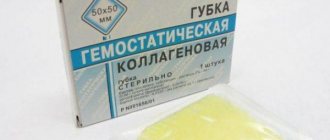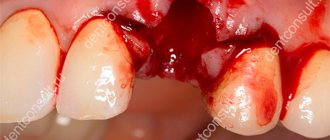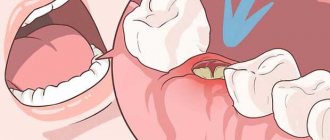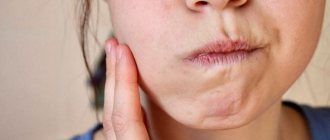16.11.2019
Tooth extraction is not a complicated dental operation, but one of the most dangerous for patients. The main risk is the subsequent possible infection of the wound that remains at the site of the extracted tooth. Moreover, it is so deep that if purulent inflammation occurs, it will certainly affect the jaw bone. Therefore, the wound must be treated with an antiseptic. Is it possible to use Miramistin after tooth extraction and how to do it correctly?
General recommendations
Extirpation ends by placing a cotton swab on the operated area. If the bleeding is minor, it can be removed after a few minutes. In case of increased bleeding, it is allowed to keep the cotton wool for up to half an hour; if the process continues, the doctor uses hemostatic drugs. When the cotton wool is held for too long, the blood clot may stick to it and fall out, and the socket with the bone will lose its natural protection from the external environment.
How to stop bleeding after tooth extraction at home:
- apply a special hemostatic sponge (sold in a pharmacy);
- make a tight swab from sterile gauze, apply to the hole and bite;
- if the problem is caused by increased blood pressure, then you need to take appropriate medications;
- use ice or frozen foods pre-wrapped in a towel as a cooling compress.
Smoking after tooth extraction is unacceptable, since cigarettes contain nicotine, which constricts blood vessels. As a result of this action, the cells do not receive the required amount of oxygen and nutrients, so the regeneration processes slow down, the risk of infection increases, scarring and improper tissue fusion are possible.
On the day of surgery, you should not rinse your mouth, engage in sports or other physical activity; it is best to go home from the clinic and rest. Routine oral hygiene or rinsing is not recommended.
In nutrition, preference should be given to soft, liquid and warm foods.
Indications for use of Miramistin
Rinsing is often prescribed in the following cases:
- before extirpation (removal) of the tooth, inflammation (pulpitis, periodontitis) was diagnosed;
- the gums were additionally injured (for example, the gumboil was opened, drainage was installed to remove pus);
- There are sources of infection in the oral cavity (carious teeth, stomatitis, tartar, inflammation of the gums, etc.).
These factors significantly increase the risk of wound infection. You can prevent it by knowing how to rinse your mouth. This disinfects the hole, destroys pathogenic microflora, so the likelihood of developing complications is reduced. The main rule is that rinsing should not be too intense. Additionally, the doctor may prescribe antibacterial and anti-inflammatory non-steroidal drugs.
Rinsing is often useful after wisdom tooth removal, since the procedure is traumatic. Eights grow normally only 20% of the time. In 8 out of 10 patients, wisdom teeth are removed at the eruption stage. Due to the peculiarities of their incorrect placement, the tissues are severely damaged, so the recovery period is delayed. Rinsing allows you to speed it up.
What medications are needed?
Antibiotics after tooth extraction are prescribed by the surgeon who performed the extraction. You can replace medications from the list with cheaper analogues, the main thing is that they have a wide range of applications, since there are different microorganisms in the mouth. Amoxiclav is often prescribed because it is effective and has a minimum of contraindications and side effects. The drugs are taken in the course determined by the doctor.
Anesthesia after tooth extraction lasts for several hours, after which pain appears, which can be eliminated with the help of analgesics. Anti-inflammatory drugs, for example Nimesil, and vitamins to strengthen the immune system can also be prescribed.
How to rinse your mouth after tooth extraction:
- chlorhexidine;
- a weak solution of potassium permanganate;
- furatsilin;
- miramistin;
- similar antiseptics.
In addition to pharmaceutical products, rinsing can be done with soda, saline solutions, decoctions of chamomile, sage, oak bark, calendula, and eucalyptus. They not only protect against infection, but also relieve swelling and accelerate tissue healing.
Temperature after tooth extraction is one of the possible symptoms, as tissues are injured and foreign elements penetrate the body. To improve your health, you need to take antipyretics.
How to rinse your mouth after tooth extraction: list of products
If baths are prescribed on the doctor’s recommendation, or the patient makes his own decision about the need for them and knows how to do them correctly and safely, it is important to use the right medications. The choice of medicine for the bath depends on the conditions that accompanied the removal:
- If a tooth is pulled out due to severe inflammation, antiseptic medications can be used, in addition to the fact that the doctor will most likely prescribe oral antibiotics. Chlorhexidine and Miramistin can be used for the solution. The effectiveness of herbal infusions is quite low, but chamomile or eucalyptus can be used as an option.
- If tooth extraction was carried out against the background of a purulent process, you can discuss with your doctor the advisability of rinsing with a soda-saline solution.
- In situations where the cause of removal was not an inflammatory process, but the patient’s oral cavity has teeth affected by caries, it also makes sense to take baths with an antiseptic. Otherwise, a large accumulation of pathogenic bacteria can “break through” the protective barrier of the blood clot and infect the socket.
If your gums are inflamed
It is not always possible to avoid infection of the wound surface, especially when the patient neglects the advice of the dentist. In case of inflammation, you should consult a doctor for examination and identification of the causes of inflammatory reactions.
If the hole is not closed after tooth extraction, alveolitis develops. The natural plug can come off due to intensive rinsing, licking the wound with the tongue, resumption of bleeding and improper actions to stop it. Alveolitis is accompanied by acute pain syndrome. Not only the injured area may hurt, but also the throat, head, jaws, and neighboring teeth.
How long the gums heal after tooth extraction depends on various factors:
- complications of surgical intervention;
- the presence of inflammation or other complications;
- age criterion, the older the patient, the longer the healing and tissue restoration takes place;
- state of immunity, individual characteristics.
What and when to eat
During the rehabilitation period, food should be soft, mostly liquid, and have a comfortable temperature. How much you can’t eat after tooth extraction depends on whether there is heavy bleeding or not. If blood clotting is normal, then a protective clot is formed and securely attached within 2 to 3 hours. After this, the restriction is lifted. With complex extraction, the time can increase to 4.6 hours.
It is advisable to exclude spicy, sweet foods, carbonated drinks, alcohol, raw vegetables, fruits with a high acid content. Chewing is carried out on the opposite side of the jaw. It is better not to eat rough, hard food, as you may accidentally touch the wound.
Why are rinses dangerous?
After removal within 1-2 minutes, a blood clot forms in the hole - this is a reliable biological protection of the wound, preventing bacteria from entering it and causing an inflammatory process. It is under no circumstances recommended to destroy, move or wash out this clot. However, during the rinsing process, patients often wash away the protective clot, leaving the socket “dry”. Dry socket is the main cause of alveolitis.
Today, dental surgeons are more inclined to believe that rinsing not only will not help the wound heal faster, but also increases the risk of secondary infection.
Oral hygiene
It is not carried out on the first day to exclude infection and accidental injury. Chlorhexidine can be used almost immediately after tooth extraction, as it does not cause side effects; the main thing is to rinse carefully and according to the instructions. Further hygienic cleaning can be performed once a day with a soft brush, carefully avoiding the surgical area.
Floss is also used to remove food debris from between teeth and a warm saline solution is used to rinse the mouth after each meal. Do not forget about cleansing your tongue, as plaque also accumulates on it, in which bacteria actively multiply.
Removal of sutures after tooth extraction occurs on the 7th - 10th day. By this time, the wounds have already healed and restrictions on hygiene procedures are lifted. Cleaning is carried out twice: in the morning and in the evening.
Pathology and norm
With any invasive procedure, swelling occurs in the soft tissues. It goes away on its own within a few days. The same can be said about pain. Cheekbones, adjacent teeth, head, and neck may hurt. If after 3 or 4 days the symptoms do not disappear, but increase, then this indicates pathology.
What are the complications after tooth extraction:
- alveolitis, osteomyelitis, most often occurring with dry socket;
- inflammation near the seams;
- damage to the adjacent dental unit;
- perforation of the bottom of the maxillary sinus, if extraction is performed on the upper jaw;
- fracture of the alveolar process, sharp edges of the alveolus that injure soft tissues;
- neuritis of the inferior alveolar nerve;
- postoperative cyst;
- paresthesia, which is characterized by numbness, loss of sensitivity of the cheeks, tongue, jaw and other adjacent areas;
- ondogenic phlegmon, periostitis;
- a hematoma in the neck can occur in people suffering from arterial hypertension (blood leaks out of the vessels into the tissue);
- soft tissue abscesses.
Pus and flux after tooth extraction characterize an acute inflammatory process that requires urgent treatment. Purulent inflammation can occur with insufficient antiseptics during surgery or poor postoperative care, with a dry socket, when food particles get into the hole. A new surgical operation is required to remove necrotic masses.
When to see a doctor:
- on the second and third days the swelling does not subside, but the cheek continues to swell;
- the pain becomes more intense and is difficult to eliminate with medications;
- the high temperature lasts for several days, normally it should decrease within 24 hours;
- no appetite, nausea, weakness;
- when pressing on the gum, pus is released, and its edges turn red;
- when palpating the hole with the tongue, no blood clot is detected.
If inflammatory processes are started, this can lead to the melting of bone tissue, an abscess and the spread of infection.
Contraindications and some features of the use of Miramistin
The drug is not used in case of hypersensitivity to benzyldimethyl ammonium chloride. Patients diagnosed with a catarrhal form of gastritis, which is provoked by an imbalance of the positive microflora of the gastrointestinal tract, should use the solution carefully. Miramistin enhances the effect of antibiotics. When using drugs together, it is necessary to adjust their dosages. The likelihood of adverse reactions occurring when taking the solution is very low.
The use of Miramistin for more than a week is not recommended, since it has an aggressive effect on the microflora of the oral cavity. Otherwise, the number of beneficial bacteria on the mucous membrane will decrease significantly. She will become vulnerable to various diseases. For example, stomatitis may develop.
With rinsing, the pain subsides on the second or third day. Bleeding should be minimal. The saliva may be slightly pink in the first two days. If you feel worse when rinsing, or local symptoms increase rather than go away, you should visit your doctor.
How long does it take for a tooth to heal after extraction?
If the extirpation is successful and there is no bleeding, then on the second or third day the hole becomes covered with a grayish coating, and by the end of the week it becomes bright pink. When pressing on the gum, the exudate does not come out. The swelling completely subsides and the pain goes away. The processes of restoration of soft and bone tissues begin.
What not to do on the first day so as not to damage the formed clot:
- rinse your mouth intensively;
- lick the hole;
- blow your nose;
- spit;
- brush your teeth.
After two weeks, the mucous membrane acquires a healthy color, the hole is not visualized as a separate part, since by this time the epithelial layer is completely restored.
How long a wound heals after tooth extraction depends on the presence or absence of complications. If everything is in order, then after about a month the replacement of the void in the socket with bone and connective tissue is almost complete. We can talk about complete healing after 3 or 4 months. By this time, a smooth surface has formed in place of the removed dental unit, which does not in any way remind of the operation performed.











